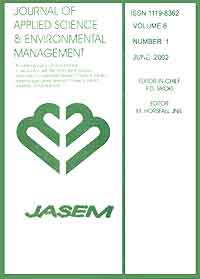
|
Journal of Applied Sciences and Environmental Management
World Bank assisted National Agricultural Research Project (NARP) - University of Port Harcourt
ISSN: 1119-8362
Vol. 11, No. 2, 2007, pp. 21-26
|
 Bioline Code: ja07020
Bioline Code: ja07020
Full paper language: English
Document type: Research Article
Document available free of charge
|
|
|
Journal of Applied Sciences and Environmental Management, Vol. 11, No. 2, 2007, pp. 21-26
| en |
Fuel gases from pyrolysis of waste Polyethylene sachets
Ademiluyi, T. & Adebayo, T.A.
Abstract
Evaluation of fuel gases produced from pyrolysis of waste polyethylene was carried out. Waste
polyethylene (pure water sachets) was pyrolysed at low and high temperatures. Pyrolysis of the waste for 300secs at
temperatures of 25°C -140°C produced 2.53% ethane, 21.67% propane and 75.82 % propylene. The volume of the
gaseous products at this low temperature is far less than the initial volume of the waste resulting into over 80%
reduction in the volume of waste generated by discarding the polyethylene waste. Fresh samples of the waste were
pyrolysed at higher temperature range from 50°C – 250°C and cooled in a condenser. The non-condensable gas
produced were collected and analyzed with Shimadzu gas chromatography. The analysis shows that C1 – C6, and
other alkenes and isoparaffins (18 ethylene monomers) were produced. The gaseous products being 75.82%
propylene at low temperatures and 48.6% (normal and Iso) butane at higher temperatures. The flame test carried out
shows that the gaseous products burns with a blue flame at lower temperature range. Above 300°C the flame becomes
more luminous and production of fuel gases stops at 550°C. Production of fuel oil from waste polyethylene led to
production of large volume of gaseous products, some of which are non-condensable at room temperature. The
gaseous products can serve as feedstock and as fuel gas.
|
| |
© Copyright 2007 - Journal of Applied Sciences & Environmental Management
|
|
